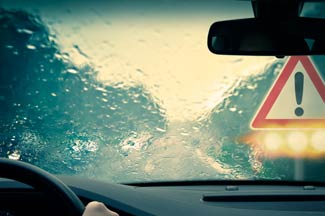 In the winter, most people prepare their cars for the weather with snow tires and an emergency kit. Less of us think about being ready for spring and summer driving weather conditions because rain is just water, right? Not exactly – rain can be a very hazardous form of precipitation that we should be cautious of when behind the wheel. The following six tips will help you be safer when caught on the road in a rainstorm.
In the winter, most people prepare their cars for the weather with snow tires and an emergency kit. Less of us think about being ready for spring and summer driving weather conditions because rain is just water, right? Not exactly – rain can be a very hazardous form of precipitation that we should be cautious of when behind the wheel. The following six tips will help you be safer when caught on the road in a rainstorm.
Roads Are Slippery from the Start
During a rainstorm, the roads are slick from the beginning. Especially when the pavement has been dry for quite some time, all of the engine oil that has seeped in creates a greasy mess when mixed with rain. If you get stuck in a downpour when you’re only a few miles away from your destination, resist the urge to speed up to get through it. You’re more likely to slide when the rain first starts.
Remember to Slow Down
It is true that rain has a different impact on driving than snow does – you can seemingly travel through rain with ease as long as you’re not in a flash flood area, whereas snow piles up, making it difficult to drive through. However, you can hydroplane in the rain, which is when your tires completely lose traction with the road and your car glides along the water’s surface. This tends to happen most often when driving at higher speeds, so be sure to slow down to at least 10 miles per hour below the posted speed limit in a rainstorm.
Change in Brake Time
Car tires are very likely to lose contact with the road in the rain, especially if you slam on the brakes when there is water on the surface of the road. Along with driving at a slower speed, it is recommended that drivers ease up on the brakes, allowing for more time to come to a complete stop than under normal circumstances. Despite your best efforts to be careful, you could still find yourself hydroplaning, but don’t hit the brakes or jerk the steering wheel.
Avoid Puddles
Although it can sometimes be unavoidable, try to dodge large puddles of standing water. It can be difficult to gauge the depth of a puddle from far away, so it is best to drive completely around it if possible. Your car’s electrical system can be seriously damaged by the sudden surge of water, possibly leaving you with a broken down vehicle in the middle of a storm. Driving through deep puddles can also lead to hydroplaning.
Watch for Lightning
There is a debate about whether or not cars are a safe place to be during a lightning storm. While it is unlikely that your vehicle itself will be struck, be on the lookout for lightning in the distance that could strike a nearby power line or tree. If a foreign object falls across the road during a storm, you may not have time to stop – no matter how slow you’re traveling. When rain turns into a lightning storm, the best plan of action is to pull over and wait it out.
DaSilva’s Auto Body can perform a full diagnostics test on your vehicle to make sure it is operating efficiently in the case of a sudden rainstorm. To schedule an appointment, contact our Naugatuck office today.




